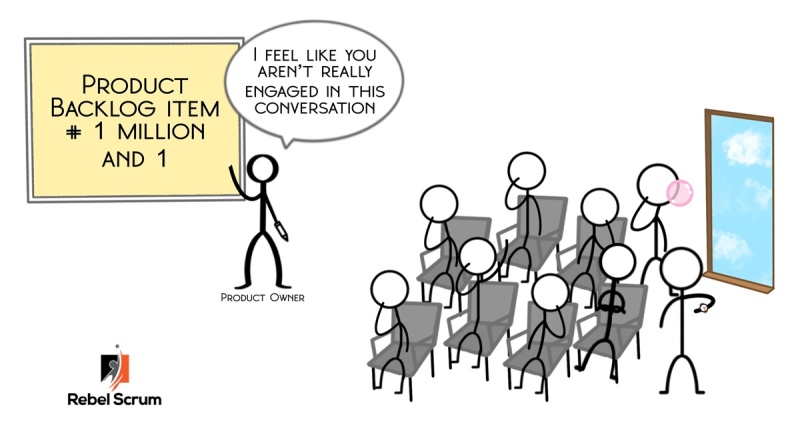The Sprint Review is the Product Owner's most valuable event. It’s an opportunity for the Scrum Team and its stakeholders to discuss what was done, and to brainstorm where to go next. When the Sprint Review goes well, it feels like a collaborative workshop. When it doesn’t, it’s a one-way communication that nobody hears. Useless.
If your Sprint Review is starting to feel a little pointless, ask yourself: Do we have a clear direction? And are we collaborating together to adjust course and find the best path to get there?
If the answer is no, then why not?
Here are five reasons your Sprint Review may not be going as well as it could be — and what to do about it.
1. The Team Isn’t Really Empowered
Sometimes, the problem isn’t the Sprint Review itself — it’s the structure around it. If your Scrum Team doesn’t have real decision-making authority, it’s hard to have a meaningful discussion about the product’s future.
Maybe the team is organized around technology silos instead of products. Maybe they’re waiting for direction instead of owning outcomes. In either case, the Sprint Review ends up being a status update rather than a working session.
When teams are empowered to make decisions about how to meet goals, the conversation shifts from “Here’s what we did” to “Here’s what we learned and where we’re heading next.” That’s when the Sprint Review starts to matter again.
2. The Sprint Review Has Become a Demo
Be honest — is your Sprint Review just a demo? Are people sitting in silence while one person clicks through slides?
Try something radical: ask stakeholders to react. Ask them what they think of what was delivered. Ask which Product Backlog item they found most valuable - and why. Invite them to vote on what they’d like to see next.
No one wants to attend a meeting where they don’t contribute. The purpose of the Sprint Review is to inspect and adapt — but too many teams stop at the “inspect” part. A learning organization doesn’t just show work; it uses feedback to change direction. That’s where the real value is.
3. There’s No Connection to the Product Goal
A great Sprint Review tells a story. It connects what was done this Sprint to where the product is heading overall.
If your Review feels disconnected — like a random list of completed tasks — take time at the start of the meeting to remind everyone of the Product Vision and Product Goal, and then restate the Sprint Goal.
Stakeholders need to see how today’s progress fits into the bigger picture. Without that context, the conversation can’t move beyond surface-level observations.
4. You’re Not Showing Meaningful Data
Stakeholders care about outcomes, not output. They want to know whether the product is solving the problem it’s meant to solve.
Instead of showing how many backlog items were completed, show metrics that actually reflect progress toward the goal. If you’re working on a claims processing system, talk about claims quality, accuracy, or payment timeliness. If it’s a customer portal, show engagement, satisfaction, or adoption.
Data helps everyone see impact — and it sparks better, more grounded conversations about what to do next.
5. You Have the Wrong Audience
Too few stakeholders, and you’ll miss valuable insights. Too many, and no one will speak up. Getting the right mix matters.
You want participants who can offer feedback, make decisions, or represent the voice of the customer. If you’re inviting people just because “they should be there,” you’re likely watering down the discussion.
Curate your invite list so the people in the room are those who can help the Scrum Team learn, adapt, and deliver value faster.
Final Thoughts
When a Sprint Review works, it feels alive — a genuine conversation about progress, purpose, and possibility. When it doesn’t, it’s just noise.
If your Sprint Review feels flat, start by empowering your team, inviting real feedback, connecting to the product goal, showing meaningful data, and bringing the right stakeholders to the table.
Scrum is built on transparency, inspection, and adaptation. The Sprint Review is where those ideas come to life — if we let them.
*******
Rebel Scrum is the host of the annual Scrum Day Houston conference. Get your tickets for 2026's event today.

